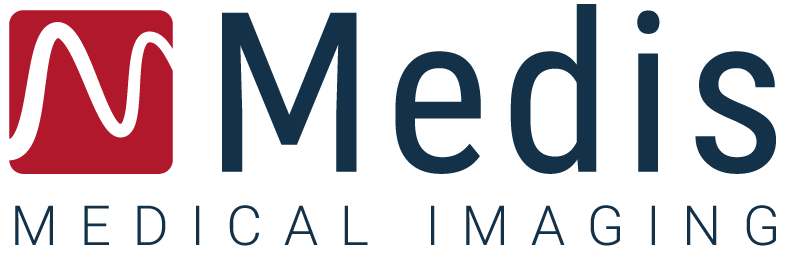Raleigh, April 7th, 2025 – Medis Medical Imaging, the leading cardiac imaging software company, announces today the FDA clearance of the latest version of its groundbreaking Medis QFR® in the USA.
Powered by AI and Deep Learning, Medis QFR® is a safe[1] and wire-free software solution that assesses angiography-derived coronary physiology in patients with ischemic CAD. Proven to enhance procedural efficiencies[2], Medis QFR® is now FDA cleared in its latest version, 3.0. This version includes significant automation and enhancements while maintaining the same accuracy[3]. During the SCAI 2025 conference in Washington DC, cardiologists from around the world will have the opportunity to experience the software firsthand.
FFR (Fractional Flow Reserve) technology and Medis QFR® (Quantitative Flow Ratio) are both used to assess the severity of coronary artery stenosis, but they differ in methodology and application. FFR is an invasive technique that requires the insertion of a pressure wire into the coronary artery and the administration of a hyperemic agent like adenosine to measure pressure drops along a coronary vessel, providing a direct physiological assessment of the possible ischemia burden. In contrast, Medis QFR® is a wire-free technique that estimates FFR values using computational fluid dynamics (CFD) principles based on angiographic images across the full target vessel of interest, eliminating the need for pressure wires and drug-induced hyperemia. In addition, its 3D QCA provides accurate anatomic information suitable for supporting clinicians to assess the size of the vessel in the stenotic area. Medis QFR® offers a faster[1], cost-effective[4], and less invasive alternative with strong accuracy[3], making it an attractive option in clinical settings where enhancing the clinician’s decision-making is a priority.
“Launching Medis QFR® 3.0 in the United States marks a significant advancement in cardiac care.” Maya Barley, PhD, CEO of Medis Medical Imaging, states, “We are thrilled that the FDA has cleared Medis QFR® 3.0 for the US market. Medis is dedicated to improving patient care and outcomes in the cardiovascular world, and QFR 3.0 is a great example of this commitment.”
Medis QFR® has been in development for over 10 years, ever since the concept of using X-ray technology to assess coronary physiology without a pressure wire was first published by Professor Hans Reiber. Supported by extensive clinical evidence across more than 270 peer-reviewed publications, involving over 20,000 patients and 22,500 lesions, the solution has been recognized with a class I recommendation in the 2024 ESC Guidelines by the European Society for Cardiology.
Medis Medical Imaging continues to strengthen its global presence through strategic commercial partnerships, including collaborations with Terumo and GE Healthcare in the USA. As a fully vendor-agnostic solution, Medis QFR® seamlessly integrates into any cath lab environment, ensuring broad accessibility and ease of use. Current Medis QFR® users are encouraged to contact Medis for an upgrade to the latest version.
About Medis Medical Imaging
For over 35 years, Medis has been providing innovative, robust and extensively validated tools to the medical community worldwide. The heritage and core values are based on this strong purpose of contributing to a healthier society by providing the right tools to cardiologists, radiologists, researchers, and industry partners. Medis’ software is internationally appreciated for its ease of use and its clinical outcomes for patients. At Medis, quality is key, all the products are developed and validated extensively to guarantee the highest quality, without compromise. They continuously focus on the creation of clinically relevant innovative software solutions in the cardiovascular imaging domain.
References
1. Stader J. Et al., Comparison of quantitative flow ratio with instantaneous wave-free ratio and resting full-cycle ratio during daily routine in the catheterization laboratory. Catheter Cardiovasc Interv. 2023. DOI: 10.1002/ccd.30690. Epub 2023 May 17
2. Westra J. et al., Diagnostic Performance of In-Procedure Angiography-Derived Quantitative Flow Reserve Compared to Pressure-Derived Fractional Flow Reserve: The FAVOR II Europe-Japan Study. J Am Heart Assoc. 2018. DOI: 10.1161/JAHA.118.009603
3. Cortes et al. “Quantitative Flow Ratio: Meta analysis & Systematic review”. Catheterization Cardiovascular Interventions Journal. 2021 Apr 1;97(5):807-814. DOI: 10.1002/ccd.28857
4. Xu B. et al. Angiographic quantitative flow ratio-guided coronary intervention (FAVOR III China): A multicentre, randomised, sham-controlled trial. Lancet. 2021;398:2149–2159. DOI: 10.1016/S0140-6736(21)02248-0
